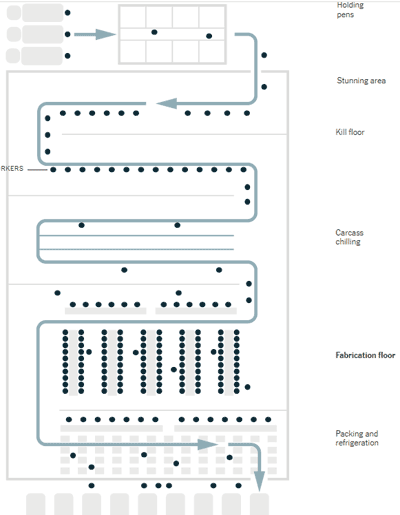For more than two months I used this First Thoughts column to review and comment on the week's news on the coronavirus and the supply chain, from the economic impact to the non-stop reports of the pandemic running wild in US meat packing plans.
But a couple of week's ago, with the country "opening up," the news flow slowed dramatically. Rules were relaxed, people were out (commonly without masks, at least in my home base of Ohio), factories and restaurants opened, and the virus threat seemed to be receding.
Gilmore Says.... |
 |
Politico added that "The number of meatpacking workers dying from the coronavirus is still rising, and employees across the country are scared to come to work."
|
 |
What do you say? |
|
| Click here to send us your comments |
| |
|
|
|
I have just one observation: "It ain't over til it's over," as former Yankee great Yogi Berra supposedly quipped.
Earlier this week, Dr. Ashish Jha, director of the Harvard Global Health Institute, said that one hundred thousand more Americans will die from coronavirus by September, doubling the country's current death toll of just over 112,000.
"We right now have about 800 to 1,000 Americans dying from coronavirus each day. If we don't have anymore spikes during summer... over the next three months, we'll cross the 200,000 mark," he told NBC's Today on Thursday
That would be much faster than it took for the first hundred thousand deaths. And that if the new open, end of lock down measures don't send infections and deaths even higher.
"We still won't be done," Jha added. "This pandemic is going to be with us until next spring when we have vaccine," Jha said, as if a vaccine is a sure thing.
Coronavirus hospitalizations have been increasing in at least nine states - mostly in the south and south-west of the country - over the past two weeks.
The possibility of a second wave - and a return to lock down policies and other restrictions - sent the stock market tumbling this week, after a strange rise of almost 40% from the bottom in late March despite a tanking economy and the risk of a second outbreak. The Dow Jones average was down 1800 points on Thursday alone.
"There's just been a happiness trade that has been out of sync with everything," said well-known CNBC commentator Jim Cramer.
Problems with the virus and the food supply are hardly over, just because the reporting in the media is largely moved on.
Bloomberg reported this week that at least 60 food-processing facilities outside the meat packing industry have seen outbreaks, with more than 1,000 workers diagnosed with the virus.
These are the first national numbers of their kind, Bloomberg said. The Environmental Working Group compiled the data using local media reports because, it turns out, there are no federal agencies reporting the data.
"The true total is almost certainly higher," Bloomberg says. "Fruit and vegetable packers, bakers and dairy workers are risking infection as the virus spreads through processing plants where employees deemed essential have mostly remained on the job during the pandemic, sometimes laboring in close quarters."
As we reported two weeks ago, as I predicted early on, there have been significant rates of infection of generally migrant workers across a growing number of farms, where the people often work, travel, and domicile in close quarters.
Then news this week that there have been almost 1000 workers on farms in Immokalee, FL, considered the country's winter tomato capital. The actual number of infections is almost certainly much higher.
But the current tomato season is coming to an end, and health professionals now worry that as those workers move north to work the summer fields in other parts of the country they will take the virus with them.
The problems at meat packing plants is hardly over, by the way. This week, for example, news that 287 workers have tested positive for the coronavirus at the northern Utah meatpacking plant owned by giant JBS.
A JBS spokeswoman said that the plant "is open at a reduced capacity."
For now, some/most meat packing plants are trying to keep the six feet of separation between workers, but as a excellent piece in the New York Times this week noted, this only works at greatly reduced volumes.
The Times piece included the graphic below of the layout of a typical meat processing plant, with the blue dots representing workers. As can be seen, the only real way to increase separation of workers is to have far less of them in the fabrication area, at least with currently factory floor space. That would mean far lower output - at least until the robots show up someday soon, I suspect.

Source: New York Times
An article this week in The Hill newspaper noted that "Meatpacking plants in the US remain hot spots for coronavirus outbreaks."
Politico added that "The number of meatpacking workers dying from the coronavirus is still rising, and employees across the country are scared to come to work."
What will be the economic impact of all this/ No one knows - forecasts are all over the map.
But I will note that the World Bank this week projected a decline in the global economy of 5.2% this year. If accurate, the decline would be the worst since World War II and nearly three times as steep as seen in the 2009 global recession.
But it warned that "even worse scenario is possible" if the health crisis extends for additional months.
That seems as likely as not to me.
Any reaction to Gilmore's column? Let us know your thought at the Feedback section below.
Your Comments/Feedback
|